to the Gasser wars of the sixties,
to Pro Street of the nineties


By Dean Kirsten
Photos by Ford of England, Henry Ford Museum, Jere Alhadeff, John Shanks and the Anglia Obsolete Archives
It would seem that 1932 was a true banner year for the Ford Motor Corporation. Not only did the company produce what many feel is the finest lineup of cars ever built: the 1932 passenger car, it was also the year Ford began to build complete cars in Britian. But Henry Ford wasn't satisfied to simply open another factory overseas and assembly American-built automobiles, he authorized the design of an entire line of unique Ford products that was catered to the European market. One that needed a smaller version of the domestic Ford automobile. The new cars and trucks were based on a 933cc, 4-cylinder flat head engine mounted in a 90-inch wheelbase chassis. Anyone that would look at these early chassis today would easily see the resemblance to the Model A Ford - but in small scale. When the Ford Dagenham factory first opened and began to mass produce completed vehicles, center stage was set for all-new Model Y sedan, a rather small looking 1935 Ford tudor. The car was an instant success in Britian and well over 100,000 were produced with little change through 1937.
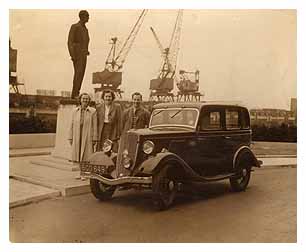
The Model Y's replacement would be the first generation that actually ressembed the Anglia that most of us are familiar with. In 1937, Dagenham released a new Ford Eight sedan, or sometimes refered to as a "7Y," still retaining the 933cc 4-cylinder engine and components of the past. A 1/4-ton van was also debuted in this configuration, first called a Fordson, later changed to Thames. The most noteable change in these vehicles came from being designed entirely in England, unlike the Model Y which was spearheaded in Dearborn, Michigan.
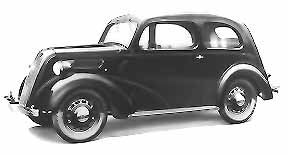
Along with the release of this new model, Ford of England also debuted a new longer wheelbase car known as the Ford Ten, or "7W" in some circles. This car boosted a larger bore engine (2-1/4-inch to 2-1/2-inch) for a total displacement of 1172cc. The Ten used a 94-inch wheelbase, while the Ford Eight stayed with the proven 90-inch stance. The Ten was available in both a 2-door, or 4-door configuration and was considered to be a more upscale car over the Eight. What is important about these two vehicles is that they set the stage for next twenty years of car and truck production. In 1939, the Ford Ten became the Ford Prefect and remained a 4-door sedan in similar styling up to 1954. In 1940, the Ford Eight became the Ford Anglia and when through several front end design changes up to 1954. Production of these vehicles came to a hault in 1941 due to the out break of the war and resumed once again in June of 1945.
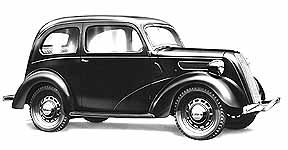
In the spring of 1948, Ford began to import the Anglia, Prefect and Thames vans (1/4-ton and 1/2-ton versions) to the U.S. and Canada under the banner "North American Sales and Service" or N.A.S.S. They were sold at selected Ford dealers across North America right along side cars and trucks made in the states. These vehicles were modified slightly for the North American market, including making them left-hand drive, fitting the headlights with sealed beams, installing front park lights on the front fenders, fitting the larger 1172cc engine, and changing the front grille on the 1948 model Anglia and Thames to a 3-hole design - a one year only change.

What appeared to be a bright new segment for Foreign Fords in the North American auto market, may have turned out to be less than expected. On April 9,1948 Ford of Britian, exported the first of what was hoped to be thousands more cars and trucks. Its initial projections were that during the first year of sales, it planned on selling over 12,000 cars and trucks to the huge U.S. and Canadian market. Actual sales however, were just over 3500 for 1948. In early 1949, the suggested retail price was dropped almost 20% in an attempt to move inventory. Even when Ford dealers across the country priced new Anglias at a rock bottom price of only $947.22, and a new Thames panel at $812.75, sales were anything but brisk. In fact, Blue Book on a two-year old Anglia was only $250!
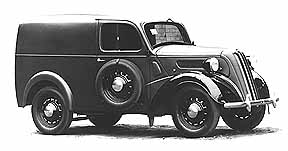
The American auto market was quickly changing and while at first, there was a huge demand for any type of new auto and truck, by the late forties, the domestic automobile manufacturers had released their first post-war designs. The buying public wanted more of everything - chrome, interior size, comfort, and big V-8 power, none of which were present in the British Fords. These pint-sized cars came equipped with mechanical brakes, wishbone suspension, wooden floors, a thermosyphen cooling system, circa 1930's!
So, for the next ten years, the Anglia, Prefect and Thames were also-rans in the automotive market. During this period, you could pick one up for a song, often less than $100. Wrecking yards from Los Angeles to New York would pile these forgotten autos up and crush them by the dozens because nobody wanted them. During the five year period that the most popular body style of Anglias were sold, 1948-1953, only about 25,000 cars and trucks were sold in all of North America. Today, only 2400 are known to exist in any shape or form.
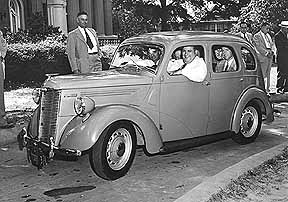
If it wasn't for hot rodders in the mid-sixties modifying them and creating some level of interest, many feel that very few modern day examples would today, still exist. In 1961, NHRA's rules set the minimum wheelbase for a "gasser" at 94-inches. The rules also stated that the body must be of American manufacturer. Both of these rules combined blew any chance of a foreign car from entering the gas classes. In 1963, NHRA allowed foreign cars to compete in the gas classes even though they were under the 94-inch wheelbase minimum. The kicker was, they could only run a small block engine and no blowers were allowed. This opened the door for the 90-inch Anglia and Thames to join the gasser ranks. The demand for these less-than-desireable foreign cars was finally on the upswing.
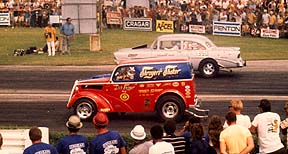
For the next four years, the number of Anglia gassers gradually increased although the supercharged divisons were dominated by the Willys and Austin - both of which had a longer wheelbase. Only a few racer took a close enough look at the Prefect and realized that its 94-inch wheelbase would be legal for this class. One such car was the "Hurst's Gasser Passer," built and driven by "Ohio" George Montgomery. The car was successfully campigned prior to his moving to a '33 Willys powered by a 427 SOHC Ford engine.

NHRA stood fast on the minimum wheelbase restrictions until 1968, but over at AHRA-sanctioned strips, no such rules existed. This opened the door for local west coast tracks like Lions and Irwindale to schedule AA/GS meets on a regular schedule. These match races packed the stands, paid well and soon many of the former injected small block-powered cars, switched over to superchargers and did remarkably well.
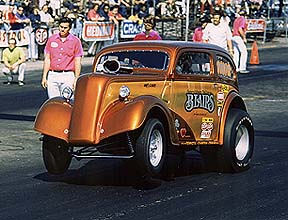
In 1965, two of the most famous Anglia gassers ever built switched from the small block Chevy to the all-new 396/427 engine. The Shores & Hess Anglia, driven by Skip Hess was one of the first racers to obtain the new big block Chevy. With the addition of a 6.71 blower, the car entered the AA/GS ranks but only under the AHRA banner. Quickly there after, Ed and Ray Kohler of the "King Kong" Anglia fame made the move to a then-huge 454-cubic inch Chevy. With both cars now competing in the AA/GS ranks, the match race madness was in full swing.
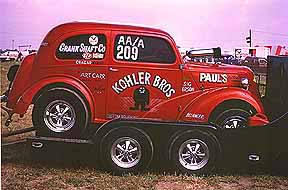
When NHRA finally let the 90-inch wheelbase cars compete with all of the goodies, the number of Anglias and Thames went nuts. Look at the entry list for the 1967 NHRA Winternationals and count the number of Anglias entered in Modified Eliminator, it's staggering. Some of the famous cars than ran at many of the nationals included the BB/GAS Anglia of Bob Panella and manually shifted by Ken Dondero, the BB/GAS Blairs' Speed Shop Anglia driven by Phil Lukens, the BB/GAS Prefect of Steve Woods, Steve Korney's AA/GAS Goldfinger, Johnny Loper's A/GAS "Little Hoss," the A/GAS Anglia of Lutz 'N Lundberg, Stickel and Riffle's B/GASSer, the Kroona/Skarda/Sandberg's AA/GAS, and more.
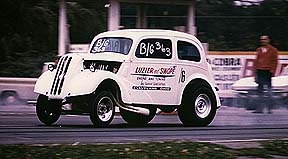
These were but a few of the hundreds of Anglias, Prefects and Thames that quickly appeared on our nation's drag strips during the sixties and seventies. Their popularity as a wild, and sometimes out of control gasser quickly grew up to the point in time that late model bodies began to appear. This was a turning point for these cars once again and as the sleeker Mustang, Camaro and other domestic cars gained popularity, the Anglias, Willys and Austin began to dwindle in numbers.
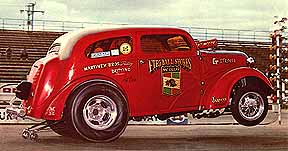
Until the mid-seventies, the outlook for these cars ever surviving looked bleek. With the rise in street rod interest taking place, with the Anglia's drag racing history, low cost and light weight, rodders began to see potential in building street-legal cars. Since this time, the number of Anglias, Prefects and Thames panels has been on the rise. Of the 2400 or so now accounted for, 80% have been modified to some extent, the majority having a small block Chevy under the hood. The remaing 20% are still in stock condition and only 5% have been completely restored back to stock.
(Please do not copy these rare photos, and place them on other web sites. It took me too damn long to locate them!)